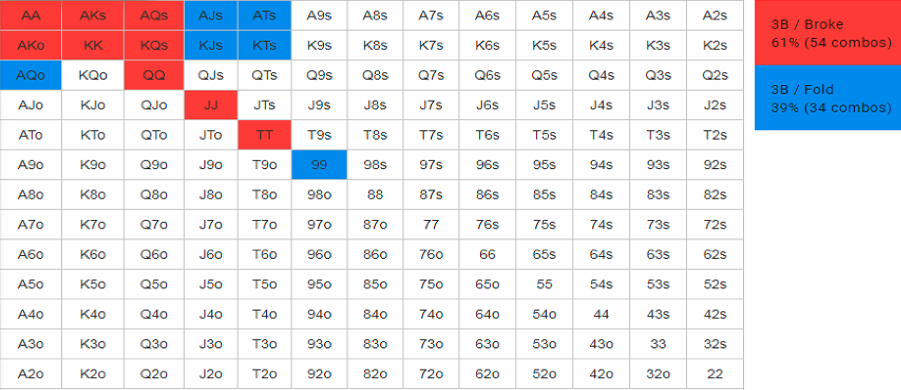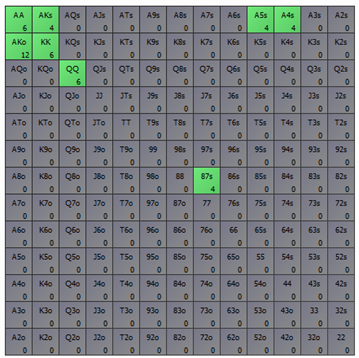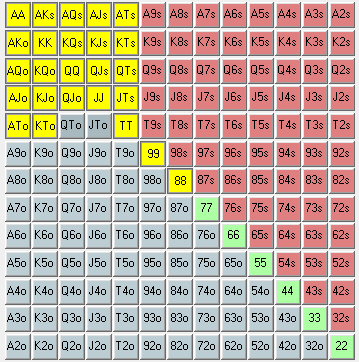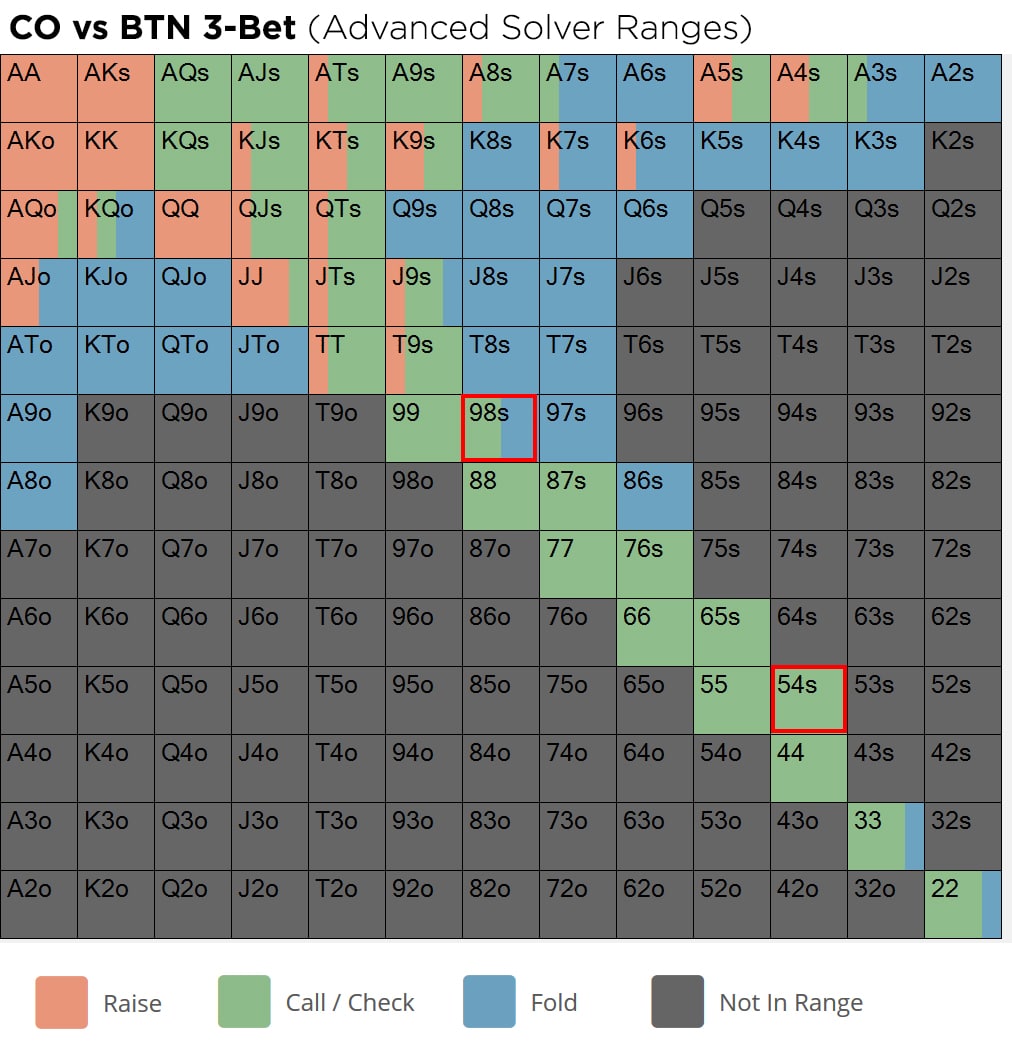Poker 3 Bet Ranges
This article will focus on pre-flop 3-Betting
You know your opponent's three-betting range is going to include a lot of overpairs to the board, other pocket pairs, and high Broadway cards. Therefore, instead of donk-betting or check-raising.
So what is a 3 bet in poker?
- The best hands for three-betting are generally the best hands: big pairs, broadway cards, suited connectors, and suited Aces. It’s not often correct to three-bet all of these hands, but your three-betting range should generally consist of some subset of them. There aren’t a lot of situations where you should three-bet 72o, or K5o for that.
- 3-Betting Ranges Our 3-betting range is a strong value-oriented game. You will notice that as our opponents open in later positions, we can 3-bet wider ranges for value, especially against BTN and SB opens. We do have a 3-bet bluffing range composed of small suited aces, 22-44 and a few combos of suited connectors.
- A 3 bet refers to any time a player makes the third bet in a pot. 3 bets can happen on any street, but this article will focus on preflop 3betting. The mandatory blinds count as the first bet, the open-raise counts as the second bet, and any raise following this will be a 3 bet.
- ' The 3 bet most commonly refers to the time when you raise the pre-flop opening raise of your opponent'
- The same rule applies to the'4 bet' and the '5 bet' (It's basically just a shortened abbreviation for saying 'The third bet in the round')
- For value
- As a bluff
- To set up a post-flop steal (or pre-flop steal)
- Let’s suppose player A opens on the button. Player B who is in the big-blind knows player A likes to open an extremely wide range from the Button. Player B decides to 3 bet bluff.
- Player A however, by now, knows that player B knows that he is open-raising wide. Player A decides player B’s 3 betting range is wide enough and light enough to put In a 4 bet bluff. Player B though, knows that player A knows his 3 bet range might be light, and decides to 5 bet bluff assuming player A’s 4 bet range is sufficiently light.
- Usually the 3bet/4bet/5bet game ends here, because 100bb deep the stacks will often be all-in. Just because player A and player B are assuming each other is light though, that doesn't mean they are. Perhaps player B, knowing player A likes to 4 bet light, started 3 betting purely for value. Or, perhaps player A, knowing player B is capable of 5 bet jamming light, started 4 betting purely for value. If either player had made such an adjustment, they’d find themselves in a very profitable spot.
So when should we 3 bet???
There are 3 main reasons why you want to 3 bet. Before you 3 bet you should have one of them in mind:
Value
We 3 bet for valuebecause we believe our hand to be stronger than our opponents hand, so we want to milk as much money out of our opponent as possible. The best players to target with value 3 bets are those with a low fold-to-3 bet. This means that they will call your 3-bet with a decent amount of worse hands. A common mistake is to 3 bet a hand which may seem like a strong hand, but against the range that villain continues with, is relatively weak.
In a 6-max game, especially at lower stakes, you should only be 3-betting premium hands for value: 99+, AJss+. Please note that this range will widen if you face a loose opponent. So if you're facing up against an opponent who's going to call all of your 3-bets no matter what hand he is holding, then you need to widen your 3bet range, 3bet more hands and raise it up more.
Generally you want to 3 bet less often for value against early position opens. 3 betting vs early opens looks very strong and you may end up isolating yourself against a range you don’t do well against. Even with the top end of your value range, you may be getting folds more often than you’d like, and flatting becomes a very viable option. Even hands as strong as QQ and AKo, you can strongly consider flatting vs an UTG open-raise.
To summarize you want to be value 3 betting against players with a 'low fold to 3 bet (Ft3bet)' and a high 'Attempt to steal (ATS)'.
Bluffs
You want to target players with a high Ft3bet and a high ATS. If a player is not folding often enough to 3 bets then you will not have a profitable 3 bet bluff. A high ATS means villain’s range will be wider in general and he will find it harder to combat 3 bets.
Most often you will want to play 3 bet poker as a bluff against positions where your opponent's range is going to be traditionally wide, i.e - BU, CO, and SB opens. However, a better player might perceive your 3 bets to be lighter against these positions and will play back more frequently. Against better opponents you can make advanced plays such as 3 bet bluffing vs UTG or MP opens. They won’t expect you to be bluffing here and may make some very tight folds.
The hands you 3 bet bluff with should be those not quite strong enough to call, but still with some potential. Hands like Q9s, T8s, Axs, Kxs. If a hand is strong enough to call, you should not be 3 betting it, for the reasons given in the KQo example. If villain is the type who will adjust by 4 betting light, you will also want to include some of the top value hands in your 3 betting range. 3 betting the top end and bottom end of your range is referred to as 3 betting a polarized range.
To Set up a Steal
Perhaps villain is the type that calls a lot of 3bets but plays fit-or-fold on the flop. You can 3 bet with the intention of taking it down on the flop. You can 3 bet pre-flop with both bluffs and value-hands, but it will possibly be easier and higher EV to do it with a merged-value range. (You won’t lose EV by not flatting your medium value hands when villain has a low Ft3bet)
In slightly more advanced games you can also 3 bet with the intention of setting up a pre-flop steal. Perhaps you know villain is going to be 4bet bluffing you a ton, so you can 3bet with the intention of 5 bet jamming as a bluff. Good hands to choose are those that have the best equity if they do end up getting called, eg pocket pairs like 88, or Axs type hands. The situations you can profitably do this at the micro-stakes are somewhat rare, but they do exist.
I am ready to take my poker game to the next level!
The preflop 3bet/4bet/5bet 'mind game' battles:
This is an entire pre-flop game in itself. The objective is to adjust the ranges you 3bet/4bet/5bet in an attempt to find an edge against your opponent’s own 3bet/4bet/5bet ranges.
The idea behind the 3bet/4bet/5bet game can be demonstrated using a simple example:
For the above situation to take place, first the correct game dynamic needs to be established. At micro-stakes, a dynamic conducive to 5 bet-bluff jamming is pretty rare. The majority of players aren't 4 betting light enough for a 5 bet-bluff to be profitable. People do 3bet light a decent amount however, so you should still be focusing on your 3 bet/4 bet ranges. Usually you only want to 5 bet shove for value. This might sound “unbalanced”, but in reality it isn't. You are just selecting the appropriate 5 bet frequency to exploit your opponents, i.e 95% value 5% bluffs.
We have all heard about 3-betting bigger out of position and smaller in position, but there are two factors in the theory of 3-betting which affect how big we should go. Position is one of them and range shape is the other. Let’s focus on this less discussed factor today. How does the sort of range we’ll be 3-betting affect the sizing we should choose? And how do we determine the shape of our 3-bet range in the first place?
Range Shape
A 3-Bet range might be linear or it might be polarised. What’s the difference?
Linear Ranges
3-Betting with a linear range means 3-betting AA and then all of the hands weaker than AA down to a certain hand which is deemed too weak to 3-Bet. It might look like [88+, all suited broadways, all suited aces, AJo+, KQo+, T9s, 98s] or in another spot it might be tighter and exclude the weaker hands in that range. Linear essentially means ‘no gaps’. When we’re 3-betting linear, we will never favour a weaker hand over a stronger one.
We 3-bet with a linear range under two circumstances:

- When we are not building a calling range against the open. In this case we are entering the pot with a 3-Bet or not at all. It would not make sense to choose to play a hand that is weaker than one we are folding, so we 3-bet from the top down.
- When Villain or population does not fold much to 3-bets. In this case we want to only increase the size of the pot for value and not for fold equity. 3-Bet bluffing is not advisable and so we 3-bet all and only those hands deemed good enough to be value 3-bets.
Polarised Ranges
A polarised 3-Bet range is one that has a value component and a bluff component. These two groups of hands are separated by a calling range. Therefore, when we 3-bet polarised, we must have a calling range to serve as a buffer between value hands and bluffs. A polarised range might look like: [JJ+ AQs+ AKo, A2s-A5s T9s 98s 87s] in the most extreme example. If our range is purely polarised, then it means we are flatting the hands in between these two groups and folding all hands weaker than our 3-bet bluffs.
One more modern option is to play a mixed polarised range. This still entails having a chunk of very strong hands that you always 3-bet for value. The difference with this range is that some of the weaker hands get mixed between 3-betting and calling. This has the advantage of increasing the calibre of the bluffs, but the disadvantage of playing less hands overall. We only have a finite amount of space for bluffing in our strategy before it becomes too bluff heavy and exploitable. This might be okay against weaker players who fold too much, but is a concern against stronger opposition. So when we 3-bet A5s as a bluff, we have less room for K3s.
We opt for a polarised range when:

- We want to have a calling range
AND
- We think Villain or population folds a decent amount of the time to 3-Bets.

The higher EV we think it is to call our medium strength hands, the less likely we are to turn them into 3-bet bluffs. When we are in position, then, BB vs a SB raise, we are very unlikely to 3-bet bluff any medium hands. A5s and the like will often just call because they are so profitable to flat and hate to get 4-bet off of their equity. Meanwhile, a hand like J4s which is around break even to flat is perfectly reasonable as a 3-bet bluff as we are not squandering much calling EV by 3-betting it instead.
Contrast this to a spot like BB vs UTG, where A5s is not a massively profitable call. In this spot we would mix the hand between 3-bet and call as both options are roughly equal in expectation and never dream of 3-betting Q4s. Thus, we are using a mixed polarised range BB vs UTG but a purely polarised range BB vs SB.
Linear Ranges want to Use Smaller Sizing

Generally speaking, big value hands increase their EV when they put more money into the pot. Medium strength hands, often called ‘tier 2 hands’, increase their EV by using a smaller sizing. The reason for this is that they do not want to filter out too many of the weaker hands in Villain’s continuing range to the 3-bet because these are the hands they dominate and perform well against. TT does not want to 3-Bet huge HJ vs UTG as there are still four uncapped ranges behind and TT will perform badly if it filters the UTG player too much.
Remember that Linear ranges are full of medium strength hands, and so they want to use a smaller size. I would 3-bet from 2.5BB to 7BB in position HJ vs UTG and from 2.5BB to 11BB out of position.
Polarised Ranges want to Use a Big Sizing

Remember, the big hands like AA, KK, QQ, and AK prefer to use a large size. The more money you can shovel into the pot with these hands, the better (unless stacks are short and building a big pot is unnecessary.) Since nutted hands are a significant part of a polarised range, polar ranges like betting bigger.
Bluffs rely on pre-flop fold equity to be profitable or break even, so when your range contains a sizable portion of very weak hands, you want to increase fold equity. Making a small 3-bet that would usually get called is not a good idea when you’re holding Q3s.
Since polarised ranges contain less medium strength hands, which prefer playing smaller pots against wider ranges, they have no reason to shy away from big sizing and every reason to utilise it.
Poker 3 Bet Ranges Poker
If I were 3-betting a polarised range in position, I would tend to go from 2.5BB to 9.5BB. Out of position I would go from 2.5BB to 12BB.
Summary
Poker 3 Bet Ranges No Deposit
- Linear ranges 3-bet from the top down without a gap. We use them either when we’re not calling anything or when fold equity is low. They want to use a smaller sizing because they contain a lot of medium strength hands that strive to keep pots smaller.
- Polarised ranges 3-bet two distinct groups of hands: value hands which are very strong and like to build big pots and bluffs which seek fold equity. We choose a polar range when we have both a calling range and reasonable fold equity. Since polar ranges contain hands that like putting more money into the pot, and no medium strength hands, they like a big sizing.
Join us on our Discord channel.